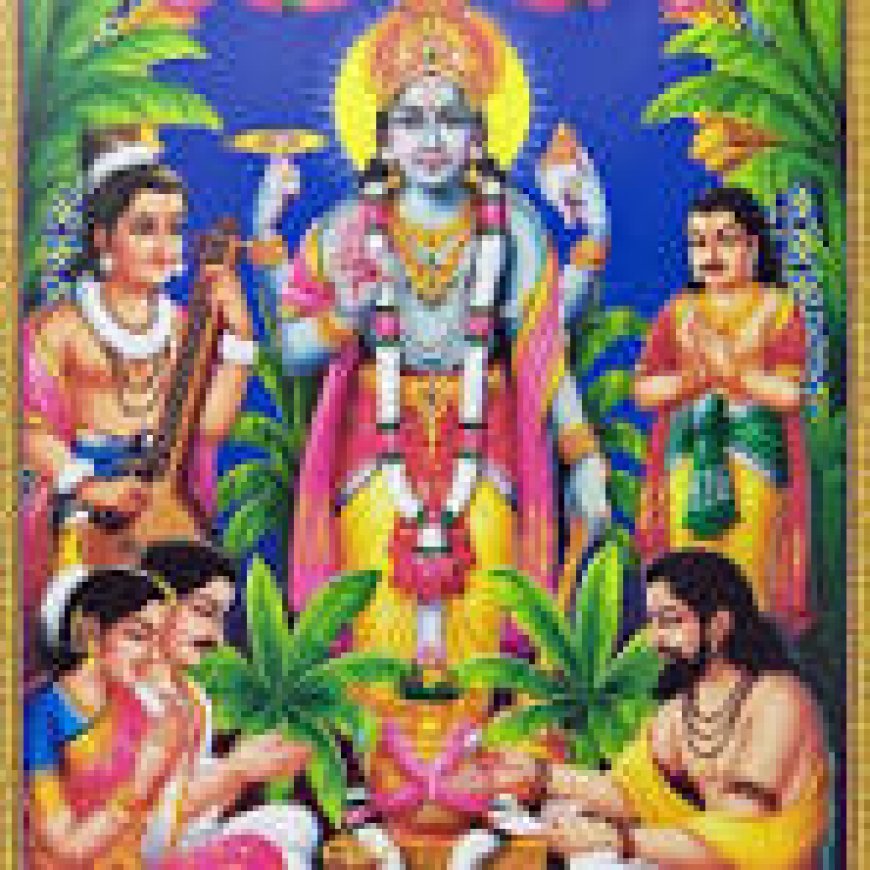Complete Satyanarayan Katha Samagri: Essential Ritual Items
The Satyanarayan Katha Samagri comprises a carefully curated collection of items that enhance the sanctity and efficacy of the ritual. Each item, from the idol of Lord Satyanarayan to the offerings of prasad, serves a symbolic purpose in expressing devotion, purity, and reverence towards the deity.

Satyanarayan Katha, a profound ritual in Hindu culture dedicated to Lord Vishnu in his form as Satyanarayan, holds immense spiritual significance. This ritual is performed to invoke blessings for prosperity, happiness, and well-being. Central to the success and sanctity of the Satyanarayan Katha is the preparation and use of specific items and supplies, collectively known as Satyanarayan Katha Samagri. These items not only facilitate the ritual but also symbolize the purity, devotion, and reverence of the devotees. In this comprehensive guide, we delve into the essential Satyanarayan Katha Samagri required for conducting this sacred ceremony.
Understanding the Significance of Satyanarayan Katha
Satyanarayan Katha is traditionally performed on auspicious occasions such as weddings, housewarmings, birthdays, and other milestones in life. The ritual involves the recitation of a narrative (Katha) that extols the virtues and divine deeds of Lord Satyanarayan. It is believed that by performing this ritual with devotion and sincerity, devotees can fulfill their wishes and attain spiritual growth.
The Katha is not merely a story but a means to connect deeply with the divine and seek blessings for oneself and loved ones. It fosters a sense of community and shared spirituality among participants, reinforcing familial bonds and cultural traditions.
Essential Items for Satyanarayan Katha
To conduct a meaningful Satyanarayan Katha, several essential items are required. Each item serves a specific purpose in the ritual, contributing to the sanctity and effectiveness of the ceremony. Here are the key items needed for Satyanarayan Katha Samagri:
-
Idol or Picture of Lord Satyanarayan: The central element of the Katha is the representation of Lord Satyanarayan, typically in the form of an idol made of clay, metal, or a picture. This idol or picture symbolizes the physical presence of the deity during the ritual.
-
Puja Thali: A puja thali, often made of brass or stainless steel, is used to hold all the necessary items for the Katha. It serves as a sacred vessel that carries offerings and facilitates the rituals.
-
Diya (Oil Lamp): A diya filled with ghee or oil is lit to symbolize the presence of divine light and dispel darkness. Lighting the diya signifies the illumination of spiritual knowledge and enlightenment.
-
Incense Sticks: Incense sticks (agarbatti) are burned during the Katha to create a fragrant atmosphere. The aroma of incense is believed to purify the surroundings and invoke positive energies.
-
Camphor: Camphor is an integral part of Hindu rituals. It is lit and waved in front of the idol during aarti (ceremonial waving of light). The flame of camphor symbolizes the burning away of ignorance and impurities, leaving behind clarity and purity.
-
Fresh Flowers: Flowers, particularly marigolds, roses, and jasmine, are used to decorate the idol and offer during the Katha. Flowers are symbolic of beauty, purity, and devotion, and their fragrance is believed to please the deity.
-
Coconut: A whole coconut, usually with its husk intact, is offered to Lord Satyanarayan. The coconut symbolizes fertility, auspiciousness, and the fulfillment of desires. It is broken during the Katha as part of the offerings.
-
Fruits: Fresh fruits such as bananas, apples, and grapes are offered as prasad (sacred food). These fruits are typically distributed among participants after being blessed during the ritual.
-
Sweets: Traditional Indian sweets like peda, ladoo, or kheer are prepared and offered to the deity. These sweets symbolize abundance, sweetness in life, and the rewards of devotion.
-
Dry Fruits and Nuts: Almonds, cashews, raisins, and other dry fruits are often included in the offerings. They represent prosperity, health, and well-being.
-
Akshat (Unbroken Rice): Raw unbroken rice grains are used during various rituals, including the Satyanarayan Katha. They symbolize abundance and prosperity.
-
Panchamrit (A Mixture of Milk, Curd, Ghee, Honey, and Sugar): Panchamrit is a sacred mixture prepared by combining milk, curd, ghee, honey, and sugar. It is used to bathe the idol of Lord Satyanarayan during the Katha, signifying purification and offering of nourishment.
-
Kalash (Pot): A copper or brass pot filled with water and adorned with mango leaves and a coconut on top is placed near the idol. The Kalash symbolizes purity, auspiciousness, and the presence of divine energy.
-
Red Cloth: A piece of red cloth or chunri is used to drape around the idol of Lord Satyanarayan. Red is considered an auspicious color in Hinduism and signifies devotion and purity.
-
Bell: A small bell is rung during the Katha to announce the beginning of rituals and to invoke the presence of the deity. The sound of the bell is believed to ward off evil spirits and create a harmonious environment.
-
Satyanarayan Katha Book: The Satyanarayan Katha book contains the narrative that recounts the greatness of Lord Satyanarayan and the benefits of performing the Katha. It is read aloud by a priest or a family member during the ritual.
-
Gangajal (Holy Water): Gangajal, water collected from the sacred river Ganges, is sprinkled during the Katha to purify the surroundings and invoke divine blessings.
-
Havan Kund (Fire Pit): In some traditions, a havan kund (fire pit) is used to perform havan (fire ritual) as part of the Katha. Sacred herbs, ghee, and offerings are placed in the fire to invoke blessings.
-
Dry Coconut (Shriphal): A dry coconut, also known as Shriphal, is often used as an offering during the Katha. It represents fertility, prosperity, and auspiciousness.
-
Kumkum (Red Vermillion Powder) and Chandan (Sandalwood Paste): Kumkum and chandan are used for tilak (auspicious mark) and adorning the idol of Lord Satyanarayan. They symbolize devotion, auspiciousness, and purity.
Preparation and Arrangement
Preparing for the Satyanarayan Katha involves meticulous cleaning of the puja area and arranging all the necessary items in an organized manner. The puja should ideally be conducted in a clean and serene environment, such as a designated puja room or a sacred space within the home. Each item should be placed thoughtfully, ensuring ease of access during the ritual.
Conducting the Katha
The Satyanarayan Katha is typically performed in the following sequence:
-
Invocation: The puja begins with the chanting of prayers and mantras to invoke the blessings of Lord Satyanarayan.
-
Offerings: Each item of offering, including flowers, fruits, sweets, and panchamrit, is sequentially offered to the deity with devotion and reverence.
-
Satyanarayan Katha: The narrative of Satyanarayan Katha is read aloud, recounting the divine deeds and virtues of Lord Satyanarayan.
-
Aarti: Towards the conclusion of the Katha, the aarti is performed. The diya (lamp) is waved in front of the idol, accompanied by the singing of bhajans (devotional songs) and chanting of mantras.
-
Prasad Distribution: After the completion of the Katha, the prasad (offered items) is distributed among all participants. Consuming prasad is believed to confer blessings and divine grace.
Significance of Each Item
Each item used in the Satyanarayan Katha holds symbolic significance:
-
Idol or Picture of Lord Satyanarayan: Represents the physical presence of the deity.
-
Puja Thali: Holds all items required for the puja.
-
Diya and Oil: Symbolizes enlightenment and dispelling of darkness.
-
Incense Sticks: Purifies the environment.
-
Camphor: Burns away impurities and negativity.
-
Fresh Flowers: Symbolizes beauty, purity, and devotion.
-
Coconut: Signifies auspiciousness and fulfillment of desires.
-
Fruits and Sweets: Offered as prasad, symbolizing abundance and sweetness in life.
-
Akshat (Unbroken Rice): Represents prosperity and fertility.
-
Panchamrit: Purifies and nourishes the deity.
-
Kalash: Represents purity and auspiciousness.
-
Red Cloth: Symbolizes devotion and purity.
-
Bell: Invokes the presence of the deity and wards off evil.
-
Satyanarayan Katha Book: Recounts the greatness of Lord Satyanarayan.
-
Gangajal: Holy water for purification.
-
Havan Kund: Used for fire rituals and invoking blessings.
-
Dry Coconut (Shriphal): Represents fertility and auspiciousness.
-
Kumkum and Chandan: Used for tilak and adorning the idol, symbolizing devotion and auspiciousness.
Conclusion
The Satyanarayan Katha Samagri comprises a carefully curated collection of items that enhance the sanctity and efficacy of the ritual. Each item, from the idol of Lord Satyanarayan to the offerings of prasad, serves a symbolic purpose in expressing devotion, purity, and reverence towards the deity. By understanding the significance of these items and performing the Katha with sincerity and faith, devotees invoke the blessings of Lord Satyanarayan for prosperity, health, and spiritual fulfillment.
The Satyanarayan Katha is not merely a religious observance but a spiritual journey that strengthens familial bonds, fosters community spirit, and reaffirms faith in divine grace. Through the meticulous arrangement and use of Satyanarayan Katha Samagri, devotees uphold ancient traditions and seek divine blessings for a harmonious and prosperous life.
In essence, the Satyanarayan Katha Samagri serves as a conduit through which devotees connect with the divine presence of Lord Satyanarayan, seeking blessings for the well-being and happiness of all. This sacred ritual continues to be cherished and practiced, preserving cultural heritage and nurturing spiritual growth across generations.
What's Your Reaction?
 Like
0
Like
0
 Dislike
0
Dislike
0
 Love
0
Love
0
 Funny
0
Funny
0
 Angry
0
Angry
0
 Sad
0
Sad
0
 Wow
0
Wow
0





































![UAE District Cooling Market [2023-2028] – Future Outlook, Latest Insights Data and Top Companies](https://s3..amazonaws.com//uploads/images/202303/image_430x256_640b00724e170.jpg)








